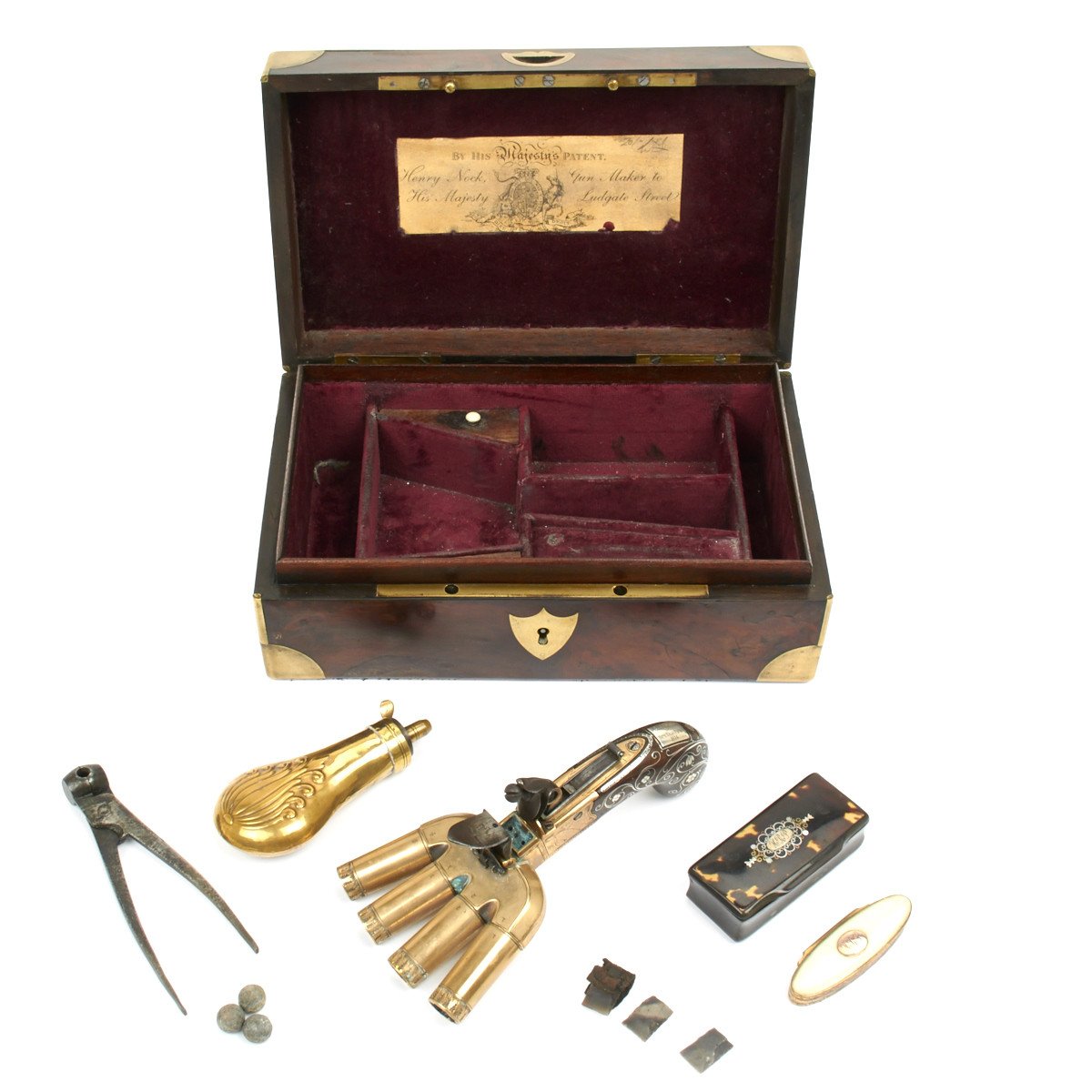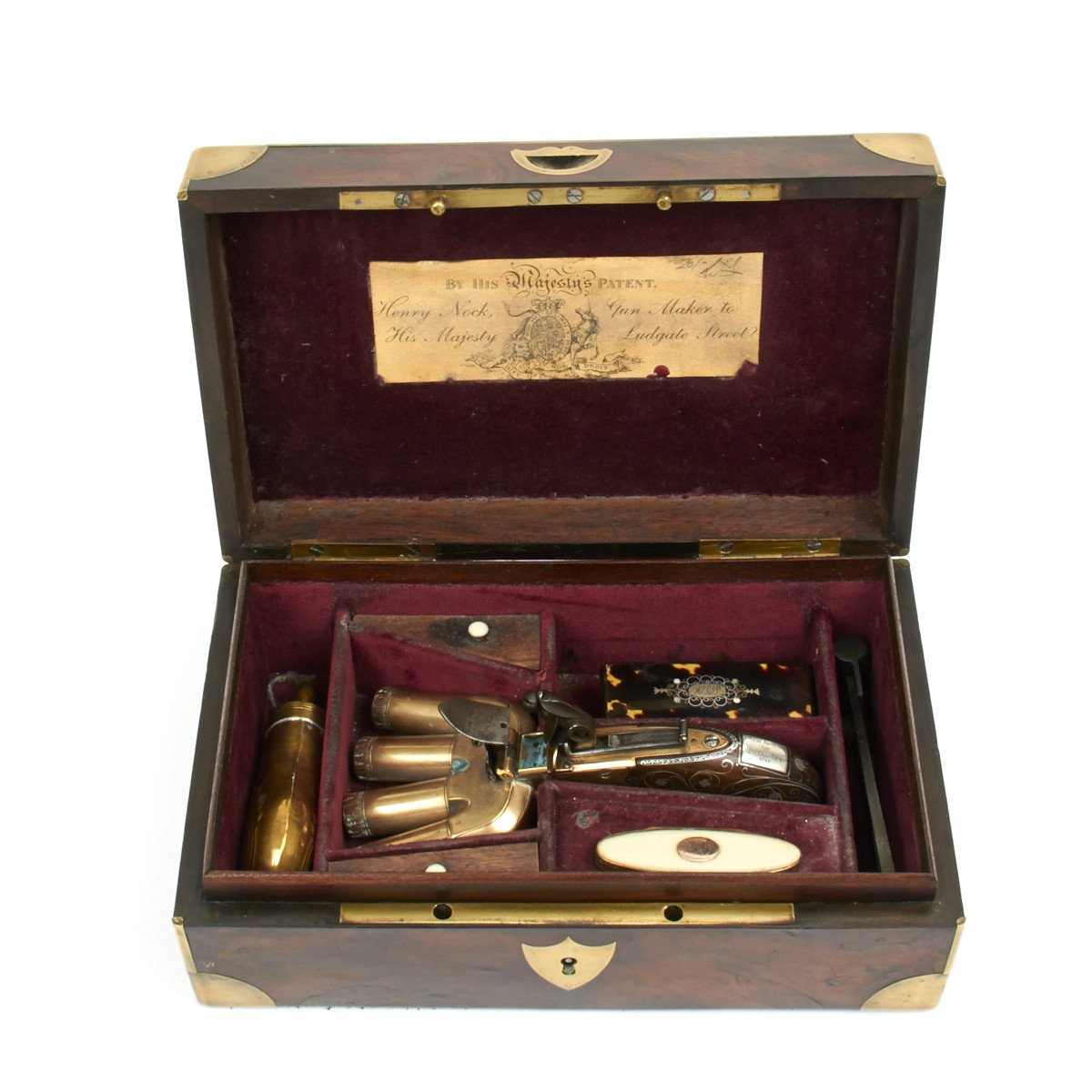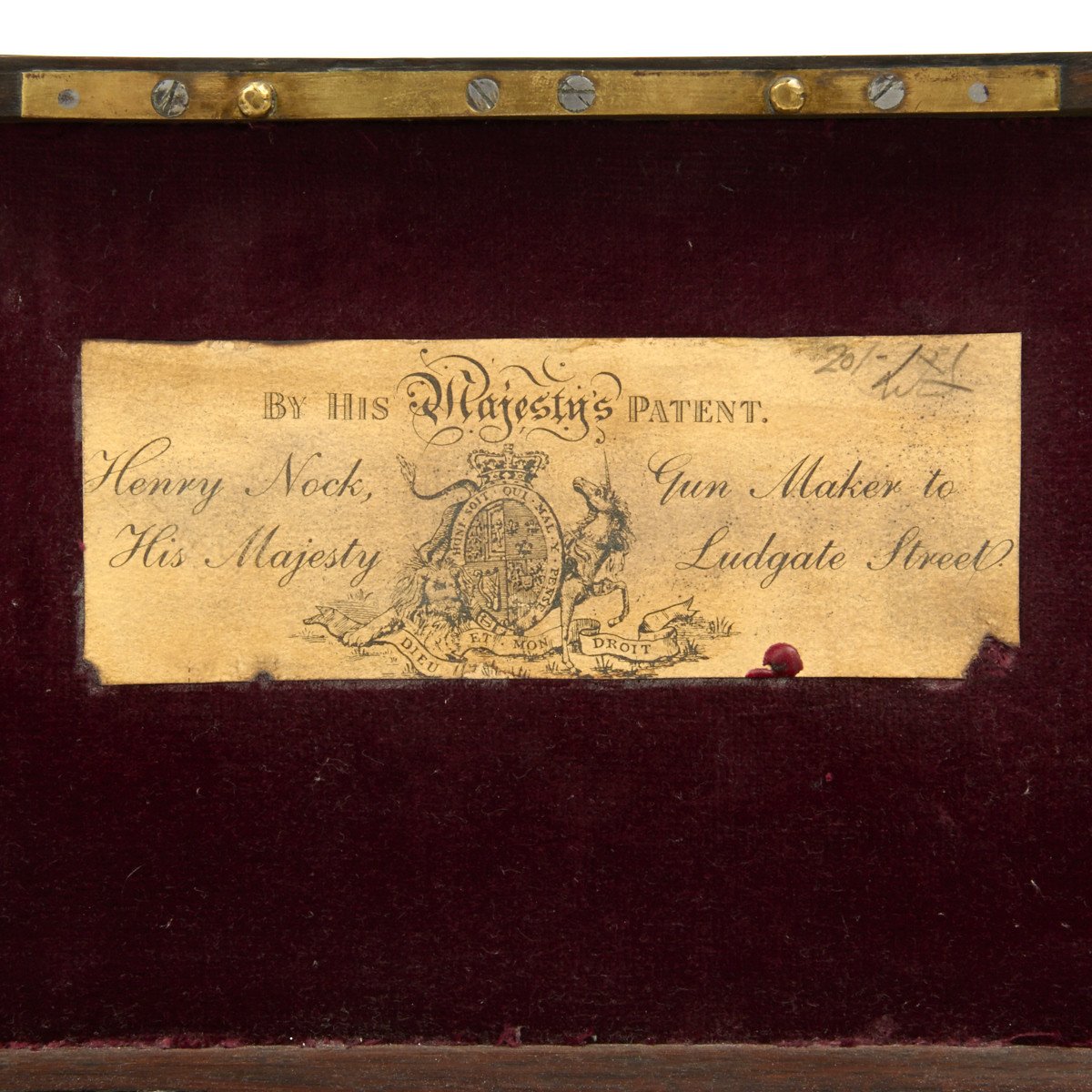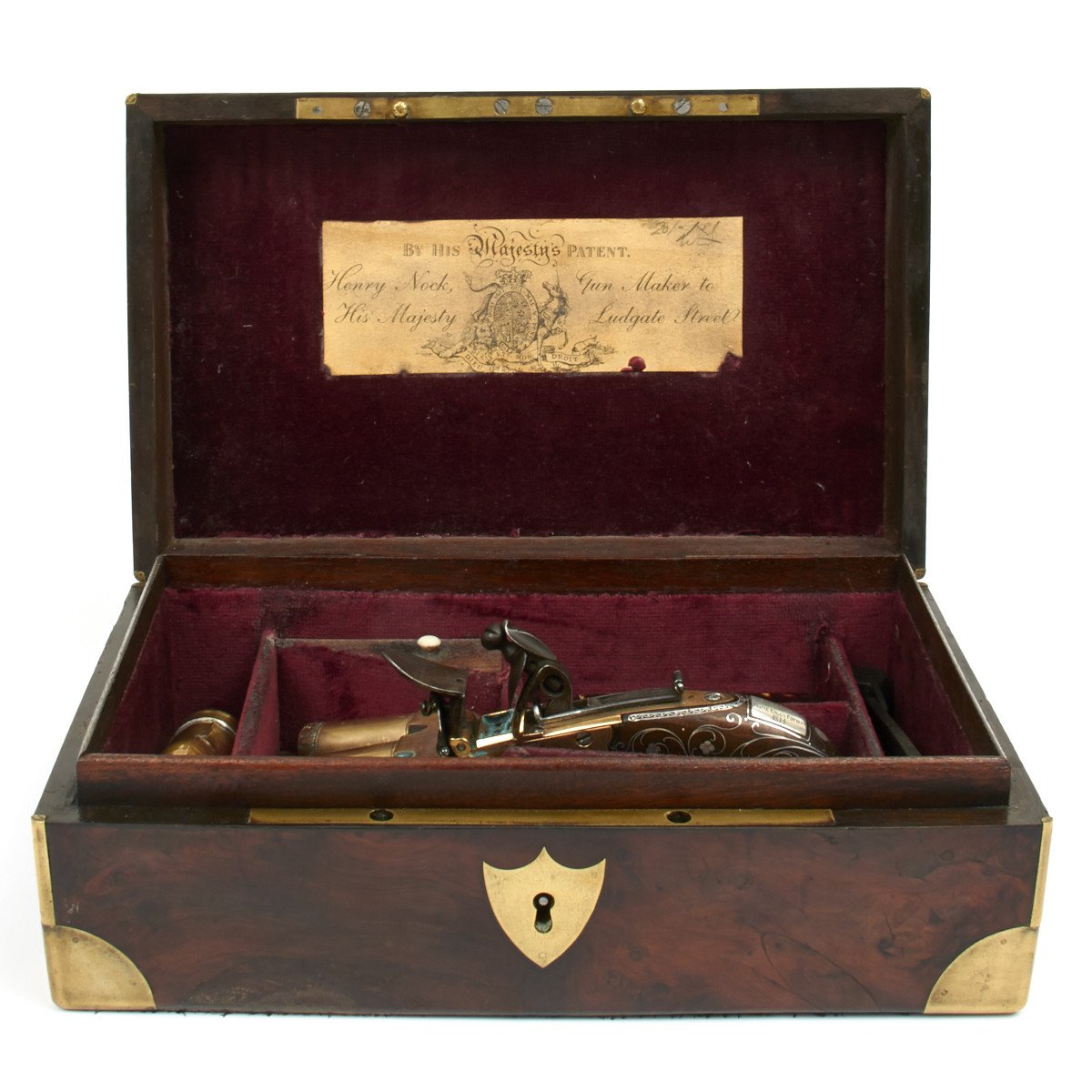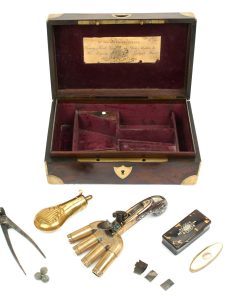Original Cased Bronze Flintlock Ducks Foot Pistol by Nock Named to Rear Admiral Sir Home Riggs Popham Dated 1814 Original Items
$ 29.995,00 $ 7.498,75
Original Item: One-of-a-kind. Rear Admiral Sir Home Riggs Popham, KCB (12 October 1762 2 September 1820), was a British Royal Naval commander who saw service during the French Revolutionary Wars and the Napoleonic Wars. He is remembered for his scientific accomplishments, particularly the development of a signal code that was adopted by the Royal Navy in 1803.
Early life and career
He was the son of Joseph Popham, consul at Tétouan in Morocco, and was his mother’s twenty-first child. Educated at Westminster School, he was admitted to Trinity College, Cambridge in 1776, though it is unclear if he took up residence in Cambridge. He entered the navy in 1778 and served with the flag of Admiral George Rodney till the end of the American War of Independence. In 1783 he was promoted to lieutenant, and was for a time engaged on survey service on the coast of Africa.
Between 1787 and 1793 he was engaged in a series of commercial ventures in the Eastern Sea, sailing, first for the Imperial Ostem Company, and then in a vessel that he purchased and in part loaded himself.
During this time he took several surveys and rendered some services to the British East India Company, which were officially acknowledged. In 1793, however, his ship was seized, partly on the grounds that he was carrying contraband, and partly because he was infringing the East India Company’s monopoly. This loss was put at £70,000, and he was entangled in litigation. In 1805 he obtained compensation to the amount of £25,000. The case was a hard one, for he was undoubtedly sailing with the knowledge of officials in India.
Service in the wars with France
While this dispute was going on Popham had resumed his career as a naval officer. He served with the army under the Duke of York in Flanders as “superintendent of Inland Navigation” and won his confidence. The protection of the duke was exercised with so much effect that Popham was promoted commander in 1794 and post captain in 1795. He was then engaged for several years in co-operating in a naval capacity with the troops of Great Britain and her allies.
His bills for the repair of his ship at Calcutta were the excuse for an attack on him and for charging him with the amount. It was just the time of the general reform of the dockyards, and there was much suspicion in the air. It was also the case that Lord St. Vincent did not like Popham, and that Benjamin Tucker (17621829), secretary to the admiralty, who had been the admiral’s secretary, was his creature and sycophant. However, Popham was not the man to be snuffed out without an effort. He brought his case before Parliament, and was able to prove that there had been, if not deliberate dishonesty, at least the very grossest carelessness on the part of his assailants.
In the spring of 1798 the Admiralty created the Sea Fencibles, a force of coastal militia, following a plan by Popham.[citation needed] On 8 May 1798 Home Popham led an expedition to Ostend to destroy the sluice gates of the Bruge canal. The expedition landed a contingent of 1,300 British Army soldiers under the command of Major General Coote. The contingent burnt the ships in the harbour and blew up the locks and gates on the Canal, but was then forced to surrender as adverse winds prevented their re-embarkation.
In 1801 he was in the Red Sea to support General Baird’s expedition to Egypt to help General Ralph Abercromby expel the French there. (On 23 May 1801, he drew 6,000 Spanish dollars for His Majesty’s ships on the expedition from the treasury on Cuvera while she was in the Judda road.
Commissioned in 1805 to study the military plans being proposed by Venezuelan revolutionary Francisco de Miranda to the British Government, Popham then persuaded the authorities that, as the Spanish Colonies were discontented, it would be easy to promote a rising in Buenos Aires. After co-operating with Sir David Baird in the occupation of the Cape of Good Hope in 1806, he led the attempt on Buenos Aires with his squadron and 1400 soldiers; but the Spanish colonists, though discontented, were not disposed to accept British rule. They rose against the soldiers who landed, and took them prisoners.
Popham was recalled, and censured by a court martial for leaving his station; but the City of London presented him with a sword of honor for his endeavors to “open new markets”,[1] and the sentence did him limited harm. In 1806 he was appointed groom of the bedchamber to the Duke of Gloucester, and in 1807 Lord Gambier appointed him captain of the fleet for the Second Copenhagen Expedition perhaps due to his familiarity to navigation of the Copenhagen Road he gained from previous service there in 1800.[citation needed] In 1809 he went on to command HMS Venerable, which he continued to command with success against the French in Spain.[5]
In 1812 and 1813 he was stationed on the northern coast of Spain where he worked with the Spanish guerrillas to successfully harry the French troops and assault French fortresses on the Basque coast while Wellington was advancing through Spain. He was promoted to Rear Admiral in 1814, and made K.C.B. in 1815.
Parliament
Popham was Member of Parliament (MP) for Yarmouth from 1804 to 1806, for Shaftesbury from 1806 to 1807, and for Ipswich from 1807 to 1812.
Death and legacy
He died in Cheltenham on 20 September 1820, leaving a large family. Popham was one of the most scientific seamen of his time. He did much useful survey work, and was the author of the code using signal flags adopted by the admiralty in 1803 and used for many years. These were most famously used for the signal “England expects that every man will do his duty”.
This amazing Flintlock Duck’s Foot Pistol is made of a light color Bronze, the wood grip is heavily inlaid with silver in floral decoration with vines and the bronze action bears the maker name on one side reading:
NOCK
LONDON
On the reverse side of the lock reads the name of the Man-o-War:
Additionally is a small silver rectangular plaque laid into the wood grip engraved:
REAR ADMIRAL SIR HOMES POPHAM, 1814
Due to the timing of the date this set was almost certainly commissioned to commemorate his promotion to Rear Admiral.
The hardwood case is of exceptionally fine quality with veneer finish with full brass trim around every edge and corners. The shield in the lid is engraved with the initials:
H.R.P.
The interior of the case bears the Nock trade label mounted inside the lid and the case is fully lined in burgundy colored velvet, showing some wear.
Also contained inside the case are the following:
Bullet mold.
Copper powder flask.
Small tortoise shell snuff box also bearing the initials H.R.P.
Stick pin in a fancy ivory/gilt container also being the initials H.R.P.
A truly lovely high quality set from a known Napoleonic era naval officer who reached flag rank in 1814.
Fast Shipping with Professional Packaging
Thanks to our longstanding association with UPS FedEx DHL, and other major international carriers, we are able to provide a range of shipping options. Our warehouse staff is expertly trained and will wrap your products according to our exact and precise specifications. Prior to shipping, your goods will be thoroughly examined and securely secured. We ship to thousands clients each day across multiple countries. This shows how we're dedicated to be the largest retailer on the internet. Warehouses and distribution centres can be located throughout Europe as well as the USA.
Note: Orders with more than one item will be assigned a processing date depending on the item.
Before shipping before shipping, we'll conduct a thorough inspection of the items you have ordered. Today, the majority of orders will be delivered within 48 hours. The delivery time will be between 3-7 days.
Returns
The stock is dynamic and we cannot completely manage it because multiple stakeholders are involved, including our factory and warehouse. So the actual stock may alter at any time. It's possible that you may not receive your order once the order has been made.
Our policy is valid for a period of 30 days. If you don't receive the product within 30 days, we are not able to issue a refund or an exchange.
You can only return an item if it is unused and in the same state as the day you received it. You must have the item in its original packaging.
Related products
Uncategorized
Uncategorized
Uncategorized
Uncategorized
Uncategorized
Uncategorized
Uncategorized
Uncategorized
Uncategorized
Uncategorized
Uncategorized
Uncategorized
Uncategorized
Uncategorized
Uncategorized
Uncategorized
Uncategorized
Armoured Fighting Vehicles of the World: AFVs of World War One (Hardcover Book) New Made Items
Uncategorized
Uncategorized
Band of Brothers ORIGINAL GERMAN WWII Le. F.H. 18 10.5cm ARTILLERY PIECE Original Items
